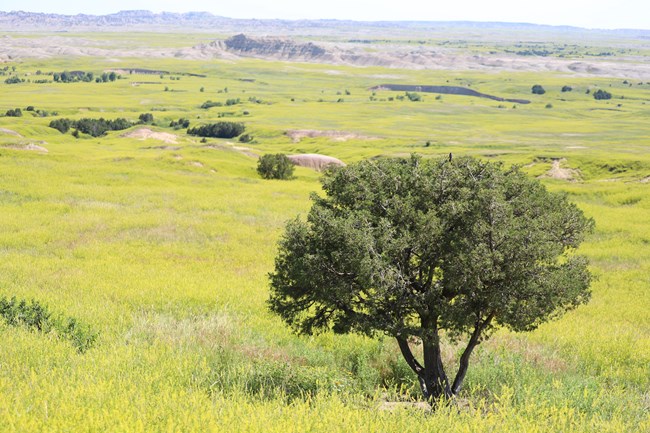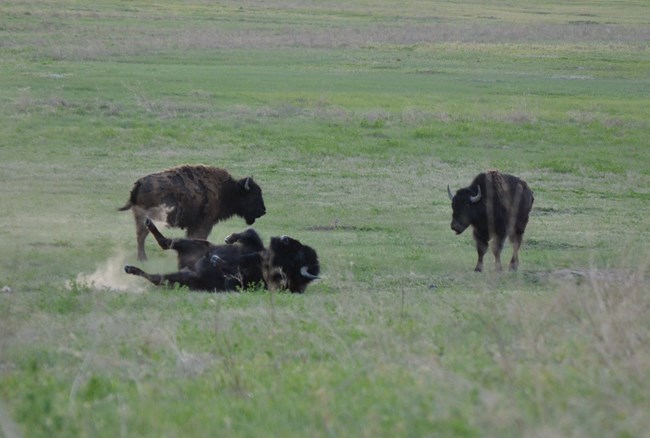Part of a series of articles titled Prairie Ecology of the Badlands.
Article
Badlands Mixed-grass Prairies

NPS Photo

NPS Photo
What is a prairie? What is a mixed-grass prairie?
A prairie is a large, open expanse of grasslands. A mixed-grass prairie is a grassland where grasses of many different heights grow. Mixed-grass prairies are the transition between eastern tall-grass prairies, where more rainfall means that taller grasses can grow, and western short-grass prairies, where the dry environment favors shorter grasses. In mixed-grass prairies, such as the grasslands surrounding Badlands National Park, grasses can range in height from ankle-high to waist-high.
Because they are in this transition zone, mixed-grass prairies have a greater number of plant species than any other type of prairie. There are over 400 plant species in Badlands National Park. Although trees, shrubs, and forbs grow in the Badlands, grasses dominate the landscape. The most common grass in the park is Western Wheatgrass, which grows one to three feet tall and is the state grass of South Dakota! For more information on the plant species in Badlands National Park, please see the species list at the bottom of this page.

NPS Photo
Why do grasses grow in prairies?
Why do grasses thrive in prairie environments? The answer is simple: climate! Mixed-grass prairies grow in semi-arid climates where rainfall is low and unpredictable. Summers are hot and dry, winter brings cold blizzards, and periodic floods and droughts create a short growing season. Wind blows unimpeded over the open plains, increasing rates of evaporation. Frequent wildfires, a lack of moisture, and thin topsoil add to the list of challenges for plants growing in the prairie. Grasses are hardy and can survive these conditions where other plants cannot.
Although grasses are very successful in this environment, local conditions in mixed-grass prairies help other plants to grow. Trees like junipers and cottonwoods grow in drainages where rainwater gathers. Changes in seasonal weather patterns -- like a particularly wet summer -- can help water-dependent plants grow.

NPS Photo / Alex Ennes
What animals live in the prairie?
Prairie ecosystems support and rely on many different animals. Prairie dogs, bison, pronghorn, and many other species munch on the grasses and forbs which grow in grasslands. Blue grama and buffalo grass retain their nutritional value in winter, supporting these grazers in all seasons. Predatory animals like coyotes, rattlesnakes, and birds of prey use the open space of the prairie as hunting grounds. Many animals also take shelter by using burrows in the prairie, like prairie dogs, badgers.
While this environment supports all of these animals, it also relies on them! Prairie dog towns are a hub of plant variability in prairies, where their digging churns up soil and encourages new plants to grow. Prairie dogs also trim the grasses around their colony, which helps forbs grow in place of grasses. Bison also help grasslands grow and stay healthy. A study at Badlands National Park by the Northern Great Plains Inventory and Monitoring Network found that native plant variability was higher in places where bison graze. Bison wallows, large depressions in the ground created by bison lying down and rolling around, collect rainwater and provide an environment where more water-dependent plants can grow.

NPS Photo
Shrinking grasslands...
Grasslands were once the most extensive biome in the United States, stretching from Canada to Mexico. Today, mixed-grass prairies throughout the Great Plains have been reduced to just 30% of their original range. How did this happen? What actions are being taken to protect the prairie?
Division and destruction of American grasslands began in the mid-1800s. In 1862, the first of the Homesteading Acts was passed. These acts encouraged people to move west by offering plots of land to any US citizen willing to live and farm that land. Most of this land was located in grasslands, where human development took over prairie ecosystems. The 1887 Dawes Act stripped over 90 million acres of tribal land from Native Americans and repurposed it for agriculture and ranching. With these acts, prairies were first divided and destroyed by human development. Prairies across the US today are still used for agricultural and ranching purposes.
Many individuals and organizations are at work to conserve prairie ecosystems. Many partners assist Badlands National Park in maintaining and managing its grasslands. The Northern Great Plains Fire Ecology Program participates in prescribed burns at the park. The Northern Great Plains Inventory and Monitoring Network has surveyed Badlands prairies since 1998. The US Forest Service not only maintains the Buffalo Gap National Grassland surrounding Badlands National Park, but also runs the National Grasslands Visitor Center in Wall, where visitors can learn more about the fascinating features of American prairies.
Select a Park:
Select a Species Category (optional):
Visit NPSpecies for more comprehensive information and advanced search capability. Have a suggestion or comment on this list? Let us know.
Last updated: February 6, 2025
